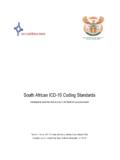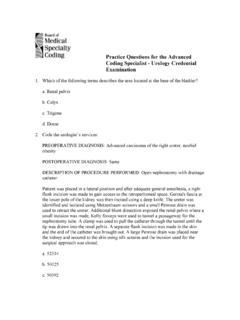Transcription of Risk Adjustment Coding for Morbid Obesity and …
1 Risk Adjustment Coding for Morbid Obesity and Malnutrition Rob Janett, MD FACP. Medical Director for Accountable Care Care New England HCC Risk Coding General Concept Review: Parent/Child codes MEAT for documentation (manage, evaluate, assess, or treat Focus on SCREENING at-risk patients for complicating conditions Code every patient every year for chronic conditions Risk Adjustment success factors Key is to capture the disease burden of the patients . payment depends on accurate diagnosis Coding Codes need to be entered at least once a year Codes need to be specific and supported by documentation Interventions: Awareness, Education, Process Improvement, Maximizing Opportunities Problem list management and staff work flows can make accurate Coding significantly easier Morbid Obesity --Tips Very common and often overlooked in Coding We should always measure BMI on a yearly basis and during/after acute exacerbations of chronic illness Morbid Obesity = BMI > 40.)
2 RAF score .365. ICD9 code Don't forget the child code of hypoventilation if the patient is also Pickwickian Don't forget the child code if there is venous stasis ulceration, heart failure, protein malnutrition Protein Calorie Malnutrition Rarely coded in practice. Often overlooked. Lost clinical opportunity and lost HCC risk Adjustment Coding opportunity. Common: Prevalence 4% in community, 22%. in SNF, 27% to 38% in hospitalized elders BMI < Or low albumen, or significant recent weight loss, etc. RAF score .713. Malnutrition ICD 9 codes PROTEIN-CALORIE MALNUTRITION. 260 Kwashiorkor 261 Nutritional marasmus 262 Oth severe malnutrition 2630 Malnutrition mod degree 2631 Malnutrition mild degree 2632 Arrest devel d/t malnutr 2638 Protein-cal malnutr NEC. 2639 Protein-cal malnutr NOS. 7994 Cachexia Protein-calorie malnutrition commonly accompanies illnesses such as: Cancer ESRD.
3 Pancreatitis Alcoholic Hepatitis Alcohol Abuse and/or Cirrhosis Dependence Anemia Obesity COPD. Celiac Disease Take Home Messages Screen patients with BMI. For patients at risk for protein calorie malnutrition because of underlying medical illness or social/psychological problems: note the weight trajectory, screen with albumin or pre-albumin labs Treat malnutrition to prevent other complications For patient who are morbidly obese (BMI > 40) treat the Obesity and screen for common complications of Morbid Obesity (sleep apnea, CHF, venous stasis, etc.). Document and code these important chronic conditions



